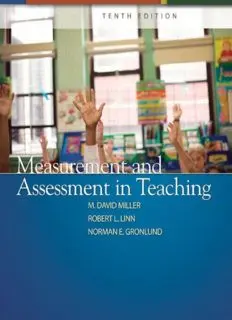
Measurement and Assessment in Teaching (Tenth Edition) PDF
Preview Measurement and Assessment in Teaching (Tenth Edition)
Table of Contents PART I THE MEASUREMENT AND ASSESSMENT PROCESS Chapter 1 Educational Testing and Assessment: Context, Issues, and Trends Educational Assessment: Barometer and Lever of Reform Five Decades of Test-Based Educational Reform Technological Advances in Testing and Assessment Public Concern About Testing and Assessment Chapter 2 The Role of Measurement and Assessment in Teaching Instructional Decisions Requiring Assessment Data Assessment, Test, and Measurement General Principles of Assessment Assessment and the Instructional Process Types of Assessment Procedures Summary of Assessment Categories Chapter 3 Instructional Goals and Objectives: Foundation for Assessment Instructional Objectives as Learning Outcomes From Overly Specific Objectives to the Thinking Curriculum Method of Stating Instructional Objectives Chapter 4 Validity Nature of Validity Major Considerations in Assessment Validation Content Considerations Construct Considerations Assessment-Criterion Relationships Consideration of Consequences Factors Influencing Validity Chapter 5 Reliability and Other Desired Characteristics Nature of Reliability Determining Reliability by Correlation Methods Standard Error of Measurement Factors Influencing Reliability Measures Reliability of Assessments Evaluated in Terms of a Fixed Performance Standard Usability PART II CLASSROOM TESTS AND ASSESSMENTS Chapter 6 Planning Classroom Tests and Assessments The Purpose of Classroom Testing and Assessment Developing Specifications for Tests and Assessments Selecting Appropriate Types of Items and Assessment Tasks Considerations in Preparing Relevant Test Items and Assessment Tasks Chapter 7 Constructing Objective Test Items: Simple Forms Short-Answer Items True-False or Alternative-Response Items Matching Exercises Chapter 8 Constructing Objective Test Items: Multiple-Choice Forms Characteristics of Multiple-Choice Items Uses of Multiple-Choice Items Advantages and Limitations of Multiple-Choice Items Suggestions for Constructing Multiple-Choice Items Chapter 9 Measuring Complex Achievement: The Interpretive Exercise Nature of the Interpretive Exercise Forms and Uses of the Interpretive Exercise Advantages and Limitations of Interpretive Exercises Suggestions for Constructing Interpretive Exercises Chapter 10 Measuring Complex Achievement: Essay Questions Forms and Uses of Essay Questions Summary Comparison of Learning Outcomes Measured Advantages and Limitations of Essay Questions Suggestions for Constructing Essay Questions Scoring Criteria Suggestions for Scoring Essay Questions Chapter 11 Measuring Complex Achievement: Performance-Based Assessments Types of Performance-Based Assessment Advantages and Limitations of Performance Assessments Suggestions for Constructing Performance Tasks Performance Criteria Scoring Rubrics and Rating Scales Checklists Student Participation in Rating Chapter 12 Portfolios What Qualifies as a Portfolio of Student Work? Potential Strengths and Weaknesses of Portfolios Purpose of Portfolios Guidelines for Portfolio Entries Guidelines and Students' Role in Selection of Portfolio Entries and Self-Evaluation Evaluation Criteria Using Portfolios in Instruction and Communication Chapter 13 Assessment Procedures: Observational Techniques, Peer Appraisal, and Self-Report Anecdotal Records Student Judgments and Reports Peer Appraisal Self-Report Techniques Attitude Measurement Interest Inventories Personality Measures Chapter 14 Assembling, Administering, and Appraising Classroom Tests and Assessments Assembling the Classroom Test Administering and Scoring Classroom Tests and Assessments Appraising Classroom Tests and Assessments Building a File of Effective Items and Tasks Chapter 15 Grading and Reporting Functions of Grading and Reporting Systems Types of Grading and Reporting Systems Multiple Grading and Reporting Systems Assigning Letter Grades Record-Keeping and Grading Software Conducting Parent-Teacher Conferences Reporting Standardized Test Results to Parents PART III SELECTING AND USING PUBLISHED TESTS Chapter 16 Achievement Tests Characteristics of Standardized Achievement Tests Standardized Tests versus Informal Classroom Tests Standardized Achievement Test Batteries Achievement Tests in Specific Areas Customized Achievement Tests Individual Achievement Tests Chapter 17 Aptitude Tests Achievement and Aptitude Tests Scholastic Aptitude and Learning Ability Group Tests of Learning Ability Individual Tests Cautions in Interpreting and Using Learning Ability Scores Culture-Fair Testing Differential Aptitude Testing Chapter 18 Test Selection, Administration, and Use Obtaining Information About Published Tests Selecting Appropriate Tests Administering Published Tests Using Results of Published Tests Chapter 19 Interpreting Test Scores and Norms Methods of Interpreting Test Scores Grade Norms Percentile Rank Standard Scores Profiles Skill Analysis Judging the Adequacy of Norms Using Local Norms Cautions in Interpreting Test Scores APPENDICES Appendix A Elementary Statistics Appendix B Professional Journals for Locating Measurement and Assessment Articles Appendix C Content Standards Appendix D Standards for Teacher Competence in Educational Assessment of Students Appendix E Test Publishers Appendix F Selected Published Tests Appendix G Taxonomy of Educational Objectives Appendix H Relating Assessment Procedures to Instructional Objectives
